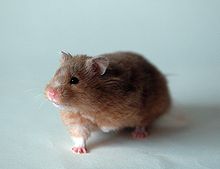Mesocricetus auratus
| Golden hamster | |
|---|---|
 |
|
| Scientific classification | |
| Kingdom: | Animalia |
| Phylum: | Chordata |
| Class: | Mammalia |
| Order: | Rodentia |
| Family: | Cricetidae |
| Genus: | Mesocricetus |
| Species: | M. auratus |
| Binomial name | |
|
Mesocricetus auratus Waterhouse, 1839 |
|
The golden hamster, or Syrian hamster (Mesocricetus auratus) is a member of the subfamily Cricetinae, the hamsters. In the wild, they are now considered vulnerable. Their natural geographical range is limited to the north of Syria and the south of Turkey, in arid habitats. Their numbers have been declining due to loss of habitat caused by agriculture and deliberate destruction by humans. However, captive-breeding programs are well established, and captive-bred Syrian hamsters are often kept as pets. They are also used as scientific research animals throughout the world.
The size of adult animals ranges from 5 to 7 in (13 to 18 cm) long, with a lifespan of two to three years (3–4 years in domestic homes, 2–3 years in the wild). Body mass is in the range of 120-125 g.
Like most members of the subfamily, the Syrian hamster has expandable cheek pouches, which extend from its cheeks to its shoulders. In the wild, hamsters are larder hoarders; they use their cheek pouches to transport food to their burrows. Their name in the local Arabic dialect where they were found roughly translates to "mister saddlebags" (Arabic: أبو جراب) due to the amount of storage space in their cheek pouches. If food is plentiful, the hamster stores it in large amounts.
Sexually mature female hamsters come into season (estrus) every four days. Syrian hamsters have the shortest gestation period in any known placental mammal at only 16 days. Gestation has been known to last up to 21 days, but this is rare and almost always includes complications. They can produce large litters of 20 or more young, although the average litter size is between eight and 10 pups. If a mother hamster is inexperienced or feels threatened, she may abandon or eat her pups. A female hamster enters estrus almost immediately after giving birth, and can become pregnant despite already having a litter. This act puts stress on the mother's body and often results in very weak and undernourished young.
Hamsters are very territorial and intolerant of each other; attacks against each other are ubiquitous. Exceptions do occur, usually when a female and male meet when the female is in heat, but even so, the female may attack the male after mating. Even siblings, once mature, may attack one another. In captivity, babies are separated from their mother and by gender after four weeks, as they sexually mature at four to five weeks old. Same-sex groups of siblings can stay with each other until they are about eight weeks old, at which point they will become territorial and fight with one another, sometimes to the death. Infanticide is not uncommon among female Syrian hamsters. In captivity, they may kill and eat healthy young as a result of the pups interacting with humans, for any foreign scent is treated as a threat. Females also eat their dead young in the wild to prevent predators detecting them.
...
Wikipedia

